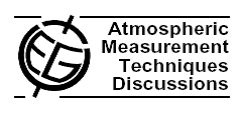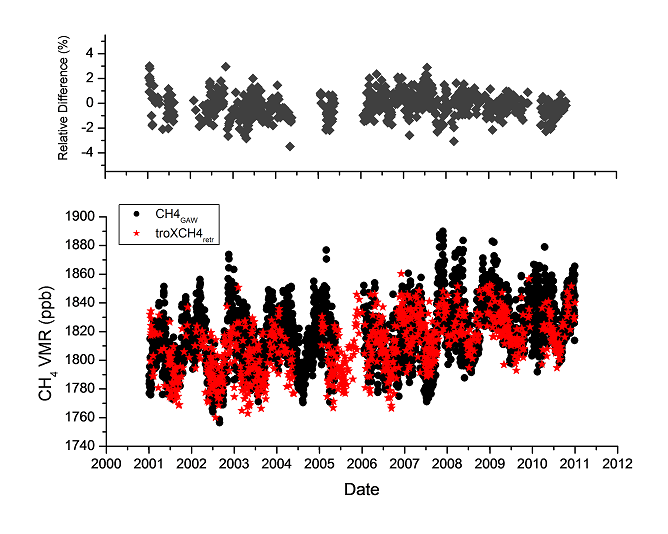New paper about long-term validation of total and tropospheric column-averaged CH4, in Atmospheric Measurements Techniques Journal
![]()

Methane (CH4) is the second most important anthropogenic greenhouse gas (GHG), after carbon dioxide (CO2). While CH4 is 200 times less abundant than CO2, it is about 20 times more efficient than CO2 to trap outgoing long wave radiation, on a 50 years timescale. The change in the CH4 mixing ratio since pre-industrial times (1750) to 2005 (from 715 to 1774 ppb) gives a radiative forcing (RF) of +0.48 ± 0.05 W m–2, ranking CH4 as the second highest RF of the GHGs after CO2 (RF of CO2 in 2005, 1.66 ± 0.17 W m–2; IPCC, 2007).
At the Izaña Atmospheric Research Center high-resolution middle infrared solar absorption spectra have been recorded for more than 12 years using Fourier Transform InfraRed (FTIR) spectrometers. We investigate the total column-averaged dry-air mole fractions of methane (totXCH4) obtained from a scaling and a profile retrieval and apply two approaches for deriving the tropospheric column-averaged dry-air mole fractions: firstly, we use the FTIR Hydrogen Fluoride (HF) total column amounts as an estimator for the stratospheric CH4 contribution and a posteriori correct the totXCH4 data of a profile scaling retrieval accordingly (troXCH4post), and secondly, we directly determine the tropospheric column-averaged dry-air mole fractions of methane (troXCH4retr) from retrieved CH4 profiles.
We compare the different FTIR CH4 data with Izaña’s Global Atmospheric Watch (GAW) surface in-situ CH4 data (CH4GAW), which in the case of the Izaña Atmospheric Research Center high mountain observatory are well representative for the free tropospheric CH4 amounts. Concerning totXCH4 the agreement between the FTIR data product and the in-situ measurement is rather poor documenting that totXCH4 is no valid free tropospheric CH4 proxy. The a posteriori correction method only removes a part of this stratospheric CH4 contribution. On the contrary the profile retrieval allows for a direct estimation of the tropospheric column-averaged CH4 amounts. This troXCH4retr data correlates well with the CH4GAW data (see plot below; correlation coefficient of 0.60, FTIR-GAW scatter of 0.97%) and both data show very similar annual cycles and trend behaviour (for the 2001-2010 time period).
Our study proves the significance of middle infrared ground-based FTIR CH4 profile retrievals as well as the robustness of the approach for achieving total and tropospheric column-averaged XCH4 data of high quality.

Fig 1. Bottom panel: CH4GAW (black circles) and tropospheric CH4 obtained from a profile retrieval (troXCH4retr). Top panel: The relative difference (FTIR-GAW)/GAW.
Full reference:
Sepúlveda, E., Schneider, M., Hase, F., García, O. E., Gomez-Pelaez, A., Dohe, S., Blumenstock, T., and Guerra, J. C.: Long-term validation of total and tropospheric column-averaged CH4 mole fractions obtained by mid-infrared ground-based FTIR spectrometry, Atmos. Meas. Tech. Discuss., 5, 1381-1430, doi:10.5194/amtd-5-1381-2012, 2012.
The paper is now accessible and open for Interactive Public Discussion until 09 Apr 2012 at: http://www.atmos-meas-tech-discuss.net/5/1381/2012/






